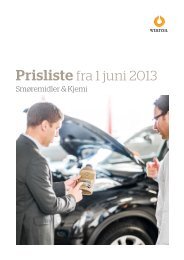Ida Ekblad MarIus Engh anawana haloba lars lauMann - Statoil
Ida Ekblad MarIus Engh anawana haloba lars lauMann - Statoil
Ida Ekblad MarIus Engh anawana haloba lars lauMann - Statoil
Create successful ePaper yourself
Turn your PDF publications into a flip-book with our unique Google optimized e-Paper software.
and the “external” free world of the artist, but also in terms of<br />
private (internal) thought structures and public (social) systems<br />
of thought.<br />
There is a Proustian element to this film, not only because<br />
it is about the nature of love and how that affects people’s<br />
understanding of their own thoughts, but also in the utterances<br />
of Carlton about his life and memories:<br />
What do last words mean? It’s all the words that come before last<br />
words that matter.<br />
At one stage, Laumann, through an intermediary, asks Carlton to<br />
tell him his favourite riddle and Carlton says:<br />
What’s the difference between a picture of Jesus and the real<br />
Jesus? It only takes one nail to hang a picture of Jesus.<br />
We are presented with a disturbing and ironic image of a man<br />
awaiting death (based on a judgement guided by religious<br />
morality) which exposes the sacrificial codes that frame<br />
execution rituals. This riddle highlights the problem of reality<br />
and representation in today’s culture and represents the type of<br />
linguistic subversiveness Laumann fosters in all his work. Carlton<br />
talks about coincidence and systems of belief, echoing motifs<br />
in the Morrissey film. The artist who loves him<br />
(Kjersti Andvig, a close friend of Laumann’s),<br />
questioning signs and signification and her own<br />
memory, begins to look for secret signs around<br />
her. In a statement which could almost be from<br />
Baudrillard or Virilio, she says: “Texas has no idea<br />
about aesthetics except in the death chamber, it’s<br />
so cinematic.” This reveals the film to be as much<br />
about truth, representation and reality as it is<br />
about the central couple. Laumann weaves the<br />
sadistic voyeurism of the death chamber into a<br />
subtle analysis of cultural voyeurism on a larger<br />
scale and the instability of identity amidst such<br />
conditions.<br />
In the installation Swedish Bookstore, we<br />
find Laumann drawing more explicitly on<br />
his bibliophiliac upbringing (his father had<br />
a bookstore). The focus of this installation<br />
is a scene from the film Top Secret, set in<br />
a bookstore, in which the soundtrack was<br />
reversed as the original directors (Abrahams,<br />
Zucker and Zucker) thought that doing this<br />
would make it sound like<br />
139

















